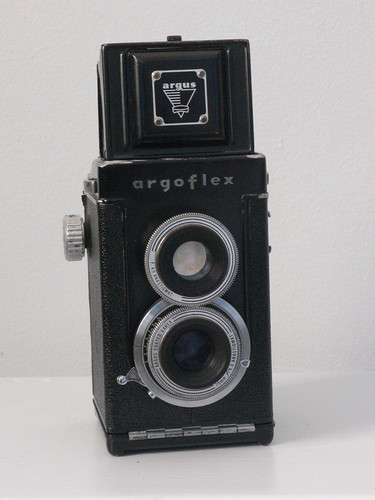Argus Argoflex EF
| Argus Argoflex EF |
|---|
|
Manufacturer: Argus
Film type: 620
|
The Argoflex EF was an entry-level TLR made by Argus from 1948-1951, a minor redesign of the earlier and less common Argoflex EM with added flash sync. This camera is the last Argoflex to be a true TLR, as every succeeding Argoflex would be a box camera with a pseudo-TLR viewfinder.
The EF is a stripped-down but reasonably conventional TLR--though of course, by this time, most TLR's had lenses fixed in a moving front standard, not the unreliable external gearing that the Argoflex shares with some of the earlier TLR's. Like the vast majority of TLR's, the EF takes 6x6 centimeter exposures, though unlike most it takes 620 rollfilm. It had an aperture range of 4.5 to 18 and a speed range of 1/10-1/200 plus time exposure and bulb. Unlike the original Argoflex, the bakelite Argoflex E, the body was made of metal and had a hot shoe for flash. Also unlike the early-production E, it cannot accept 120 at all, as the narrower 620 spools are already a snug fit within the compartments, making it impossible to load the slightly wider and thicker 120 spools. Due to the numbers produced and the entry-level quality, it is still quite possible to find the various Argoflexes for sale in working condition cheaper than almost any other TLR.
The camera is physically quite substantial, with a thick cast-metal construction overlaid with leatherette (though the camera weighs slightly less than the C3, a smaller camera.) It possesses very clean lines due to the lack of complicating controls; except for the film advance, every control is on the taking lens body. The fixed lenses are both coated Argus Varex three-element anastigmat f/4.5, with two elements fixed in the camera body and one element mounted on a helicoid for focusing. Thus it is one of the few twin-lens reflex cameras with identical lenses for the taking and viewing lenses; most TLR viewfinders were built around a lower quality lens with similar focusing characteristics to the taking lens, for economy's sake.
On top of the viewing lens barrel, placed to be visible at the same time as the finder screen, is a comprehensive depth-of-field calculator, formed by distance marks on the lens rim rotating past a scale with the focus range of each f-stop marked on it. On the rear of the camera is the red window, placed for 6x6 square exposures. This window is blocked by a pivoting guard inside the camera, operated by a small spring-loaded lever below the window. Presumably this arrangement is so that, if the camera is left in the sun with the back facing up, the light filtering through the backing paper will not eventually fog the film.
The shutter is a Wollensak Alphax, a decently fast leaf shutter. This is an everset shutter with a rather long throw, set up in a between-lens position. The Alphax is considered a mechanically straightforward unit, and multiple detailed tutorials exist online for disassembling, de-greasing and re-lubricating it if it has become fouled over time. There is a socket for a cable release immediately under the trigger. The camera possesses flash-sync, but unfortunately the modern photographer will find it impossible to mount a flash. The hot shoe is proprietary; it requires a thinner flange on the flash than a modern unit will have, and the contacts will almost certainly not line up. Add to this that most examples lack a PC socket (though some authors claim their camera has one), and it becomes clear that only an Argus flashgun or a very cunningly devised substitute will function with this camera. Whether a modern flash can somehow be connected with a homemade adapter is a question for the ages.
The main viewfinder is rather basic, being slightly dim in the best lighting conditions and almost invisible in subdued light or with strong light overhead. The camera does, fortunately, possess a sports finder for quicker composition. This simple frame finder is formed by erecting the viewfinder hood and pressing the front plate with the Argus logo to fold it back towards the viewing screen. Doing so reveals a large window in the front of the hood. The plate will catch on two catches on the back plate of the hood, just below a small peep-hole which forms the rear of the finder. There is also a folding loupe to assist in focusing using the reflex finder, though the focal distance of the magnifying lens rather necessitates the photographer to put his or her eye right up to the loupe to see a clear image through it, and it is difficult to see the entire frame through the loupe.
Other features include a tripod mount, solid brackets for straps, and an ever-ready leather case either sold with the camera or separately.
